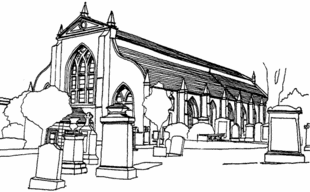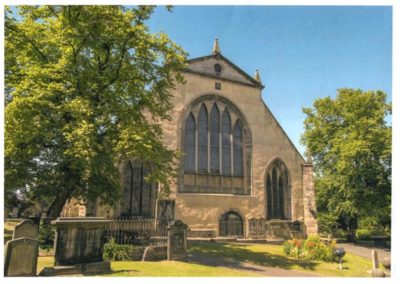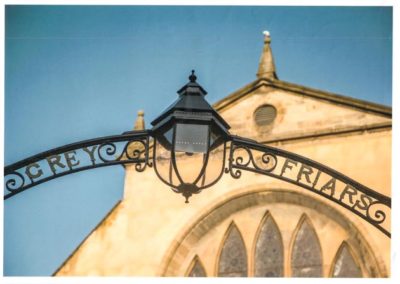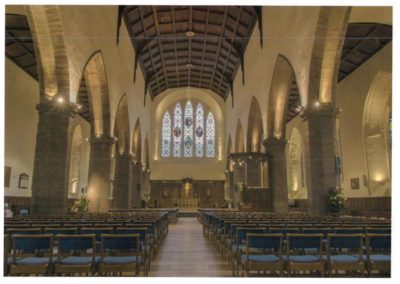Greyfriars Kirk, Edinburgh
Denomination: Church of Scotland
Address: Greyfriars Place, Edinburgh, EH1 2QQ
Local Authority: Edinburgh
Listing: A
WEBSITE
Church Overview
The building was the first post-Reformation church to be built in Edinburgh, with work beginning on the new kirk in 1601 and not completed until 1620. The original Baroque and “Gothic Survival” styled church, that emerged in the centre of the site formerly occupied by a Franciscan Friary dissolved in 1559, consisted of six bays, with an aisled nave and a square-plan tower on its west end.
Built by the Town Council of Edinburgh, in the tumultuous years that followed its erection the church would play an important part in national events. The National Covenant was first made public here in 1638, a document signed by many of Scotland’s nobles, ministers and thousands of ordinary Scots, who pledged themselves to defend Scotland’s rights and its Presbyterian religion. During the Wars of the Three Kingdoms, the building was reduced to status of a barracks for Cromwell’s troops from 1650-53 while the self-styled “Protector’s” forces occupied Edinburgh. After the deposition of Richard Cromwell in 1659, General Monck, commander of the English forces in Scotland, gathered his officers in the church to decide their next course of action, which would ultimately see the occupying army abandon Scotland’s capital and return southwards across the Tweed.
Upkeep of the church during the latter 17th century proved a heavy burden for the Town Council. Following the defeat of the Covenanting forces in 1679 at the Battle of Bothwell Bridge almost 1200 of their number would be imprisoned and held, awaiting trial, torture and execution, for several months in terrible conditions for several months in a small enclosure of the kirkyard outside, still known today as the “Covenanters’ Prison”. On the 7th May 1718, a magazine of gunpowder, belonging to the town’s gunmakers and stored in the church’ tower by the Town Council, exploded, completely destroying the tower, damaging part of the church and many monuments outside. Despite this disaster, the Town Council erected another gunpowder magazine elsewhere in the kirkyard that they maintained until the beginning of the 19th century!
Basic repairs were completed to the church soon after, but further alterations followed. Overseen by architect Alexander McGill, by the end of 1722, the building split was divided into two distinct spaces by a new central wall, providing four bays each for the use of two separate congregations. A fire in January 1845 gutted part of the building, with the damage to several stones still visible today. Repairs were overseen by architect David Cousin and the minister, the Rev Robert Lee, introduced in 1857 the first stained glass windows to be installed in a Scottish church since the Reformation, along with an organ, liturgical worship and hymn singing.
In 1929, the two separate congregations formally united. Between 1932 and 1938 the building was restored as a single entity and the dividing wall removed by architect Henry Francis Kerr. Further significant internal refurbishments occurred in 1990, 2004 and 2012 as the congregation formed unions with the congregations of the nearby Highland, Tolbooth & St John’s Church and Kirk o’Field Parish Church.
The interior today is adorned by some the fine mid 19th-century coloured glass by James Ballantine, Marjorie Kemp, Ballantine & Gardiner and Douglas Hogg. A magnificent three manual pipe organ, with almost 3,400 pipes, was installed by organ-builder Peter Collins Melton Mowbray in 1990. Notable memorials include those to church-builder Margaret, Lady Hay of Yester, Robert Adam, Alexander Nisbet and Sir Walter Scott.
The oak dais, wall panelling, communion table in the east end and the kirk’s impressive Jacobean-style pulpit were all designed by Herbert Lewis Honeyman, the oak eagle lectern was relocated from Lady Yester’s Kirk when it closed in 1938. The Renaissance era font was brought from Rome in 1912 and gifted to the church by historian William Moir Bryce and many of the furnishings in the west end of the church were relocated from the chapel in the nearby Highland, Tolbooth and St John’s church when it closed in 1979.
Other artefacts housed in the church, or its small museum located under the organ, include selected items from its historic communion ware and from the collections of the churches Greyfriars has merged with over the years, an original copy of the National Covenant of 1638, Robert Trail’s sword and an original portrait and other items relating to its famous canine visitor, Greyfriars Bobby, who is buried near the gate to the kirkyard.
The historic kirkyard outside is open all year around and attracts hundreds of thousands of visitors. In addition to the remains of the famously loyal Skye Terrier and its owner John Gray, the cemetery contains a wealth of remarkable grave memorials and tombs commemorating and holding the great and the good of Edinburgh that were buried within its walls. There are also two mortsafes, used to prevent the grisly trade of digging up fresh corpses to supply the needs of medical students at the nearby University prior to the 1832 Anatomy Act. In recent years, vast numbers of visitors have also been drawn to the graveyard searching for memorials rumoured by tour guides to have provided inspiration for JK Rowling for the names used in the Harry Potter series of books, a story refuted entirely by the author herself.
Services
Sundays: 11.00am and 12.30pm (Gaelic), 1st Sunday of month Holy Communion 9.30am; Thursdays: all year Lunchtime Service.
Opening Arrangements
Open April to October: Monday to Friday 10.30am-4.30pm, Saturday 11am-2pm; November to March: open by arrangement. The church can be hired for special events which can impact opening times. Check their website for details
Disclaimer
The information about churches in Scotland’s Churches Scheme has been provided by the congregations or taken from the Historic Scotland list and published sources, in particular, the Buildings of Scotland volumes and the RIAS Illustrated Architectural Guides. To contact this specific church please complete the Contact this Church form above. The information is not authoritative; please contact Scotland’s Churches Trust to let us know of any errors or omissions.




